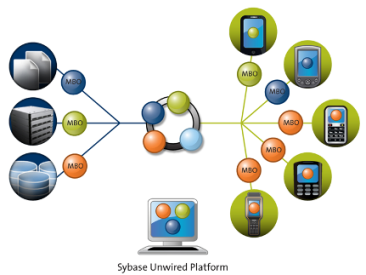The cornerstone of the solution architecture is the concept of the mobile business object (MBO). For native Object API applications and mobile workflows, mobile business objects form the business logic by defining the data you want to use from your back-end system and exposing it through your mobile application or workflow.
MBO development involves defining object data models with back-end EIS connections, attributes, operations, and relationships that allow filtered data sets to be synchronized to mobile devices. MBOs are built by developers familiar with the data and transactional requirements of the mobile application, and how that connects to the existing EIS data sources.
- Are created using the Unwired WorkSpace graphical tools. These tools simplify and abstract back-end system connections, and provide a uniform view of transactional objects
- Are reusable, allowing you to leverage business logic or processes across multiple device types.
- Future-proof your application; when new device types are added, the same MBO can be used.
- Provide a layer of abstraction from Unwired Server's interaction with heterogenous back ends/devices, as shown in the following diagram.
- Implementation-level details – metadata columns that include information about the data from a data source.
- Abstract-level details – attributes that correspond to instance-level properties of a programmable object in the
mobile client, and map to data source output columns. Parameters correspond to
synchronization parameters on the mobile client, and map to data source arguments. For example, output of a SQL SELECT query are mapped as attributes, and the arguments in the WHERE clause are mapped as synchronization parameters, so that the client can pass input to the query.
MBO operations include parameters that map to data source input arguments. Operation parameters determine information a client passes to the enterprise information system (EIS).
- Relationships – defined between MBOs by linking attributes and parameters in one MBO, to attributes and parameters in another MBO.
Developers define MBOs either by first designing attributes and parameters, then binding them to a data source; or by specifying a data source, then automatically generating attributes and parameters from it.
A mobile application package includes MBOs, roles, and data source connection mappings, and other artifacts that are delivered to the Unwired Server during package deployment.
When the data model is complete, code artifacts are generated. The MBO package, containing one or more MBOs is deployed to Unwired Server. Other MBO artifacts are used to develop a mobile application using Native Object API or HTML5/JS Hybrid App API — when the application is deployed to a device, the MBO data set resides on the device. On device data changes are synchronized to the MBO on the server and then to the EIS back end. Back end changes are communicated to the device via the MBO on the server that sends a notification to the device and updates the MBO data on the device.
- Sybase Unwired WorkSpace - Mobile Business Object Development
- Developer Guide: Unwired Server
